
The Design Village spotlights 10 design projects
Dezeen School Shows: a project that aims to bring awareness to coral bleaching and an aqua farming-based intervention to improve Rohingya refugees' food security are included in Dezeen's latest school show by students at The Design Village.
Also included is mental health risk assessment in the metaverse and non-intrusive stem cell-extracting menstruation products.
The Design Village
Institution: The Design Village
Course: Bachelors of Design and Masters of Design
Tutors: Lena R. Gupta, Mudita Pasari, Vatsal Agrawal, Anusha Dhawan, Mridu Sahai, Shemal Pandya, Sneha Ravishankar, Ananya Agrawal, Ritwick Nandi, Vatsal Agrawal, Nikhil Tailang, Akanksha Chhajer, P. Dharun Rao and Pritesh J. Maru Guided.
School statement:
"The Design Village (TDV) is a design institute based in Noida, India offering undergraduate and postgraduate programmes in design.
"TDV is a multidisciplinary, future-looking, experience-driven school that believes in impact through design. For TDV, design does not only solve problems of today, but also proposes new ways for the future.
"To fulfill this ambition, TDV aims to nurture and educate individuals by giving them a choice to not limit themselves to any particular field of design.
"Students may choose to not specialise in a particular discipline, but can be independent non-silo designers who can impact and change the world through design in any and every medium imaginable.
"Design today is about altering conditions, changing behaviours, creating experiences, finding new meanings, building identities and evolution. And therefore, design education today is about critical thinking, communication, collaboration, cultural awareness, civic engagement, collective responsibility and creative leadership."
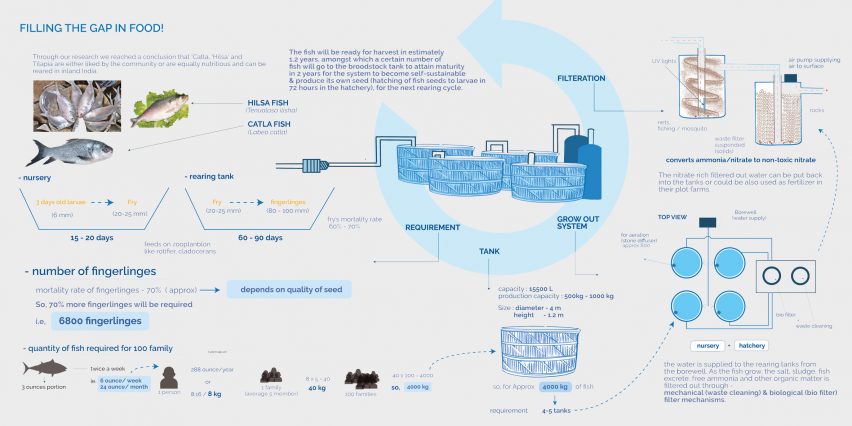
Self reliance for the persecuted by Manisha Bisht, Mayank Raj and Yukti Anand
"A team of TDV students ventured to address the UN SDG – Zero Hunger through an aqua farming-based intervention that aims to bring food security and self-reliance for Rohingya refugees residing in temporary settlement in New Delhi, India.
'The project further aims to build an identity for the refugee community, while providing for the nutritional requirements of the otherwise neglected community.
'This project won first place at the Cumulus Green 2022: Nurturing Our Planet – the signature biennial student competition.
"Its current focus is how to transform our food systems to end food insecurity by creating better conditions for an equitable and environmentally prosperous world."
Students: Manisha Bisht, Mayank Raj and Yukti Anand
Course: Cumulus Green 2022 – Nurturing Our Planets
Tutors: Lena R. Gupta and Mudita Pasari
Emails: manisha.bisht_pg21[at]thedesignvillage.org mayank.raj_ug20[at]thedesignvillage.org and yukti.a[at]thedesignvillage.org
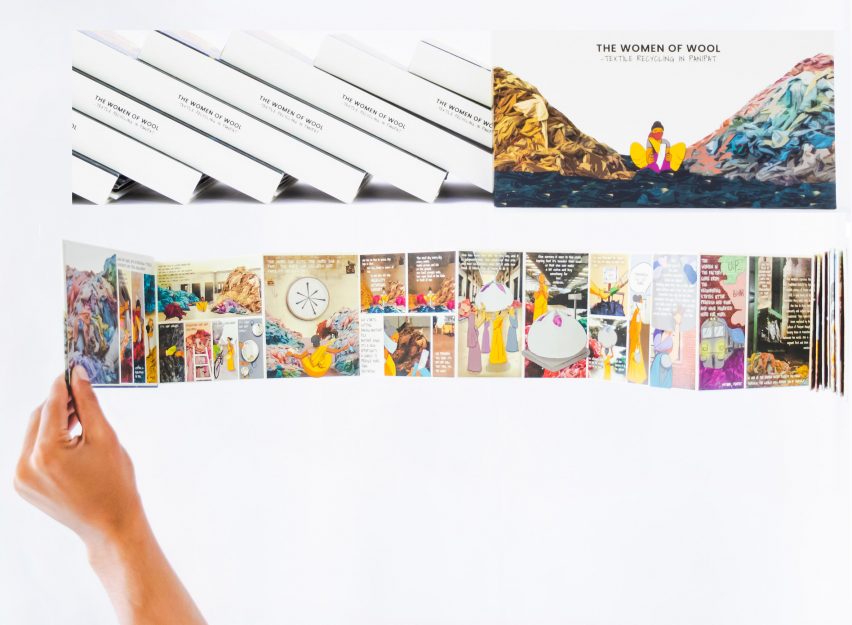
The Women of Wool – textile recycling in Panipat by Pradeep Singh, Shubham Mishra, Kavya Bhadwal, Ishant Raj, Ishita Mahajan and Shikha Sasheendran
"The women of Wool is an end manifestation of a social audit conducted for a European company, to map their supply chain across the globe.
"Through extensive ethnographic research, tracing the sustainability of the larger recycling process, the project creates a narrative outlining the situations of the local women and throws light on the agency they may or may not have.
"The visual narrative form tells real stories, preserving the humanness and identity of the workers while not exoticising pain when calling for international action.
"Social audits usually end in a boardroom, however, we as a design team would rather have the social audit be read by the consumer buying a product.
"Audits need to transform to create true impact, for they have long been based on intimidation of local communities, who are forced to answer questions they often do not fully understand.
"This project is a contribution to creating safe spaces of communication where each story can be heard, documented and reported."
Students: Pradeep Singh, Shubham Mishra, Kavya Bhadwal, Ishant Raj, Ishita Mahajan and Shikha Sasheendran
Course: The Design Cell
Tutors: Anusha Dhawan, Mudita Pasari and Mridu Sahai
Email: thedesigncell[at]thedesignvillage.org
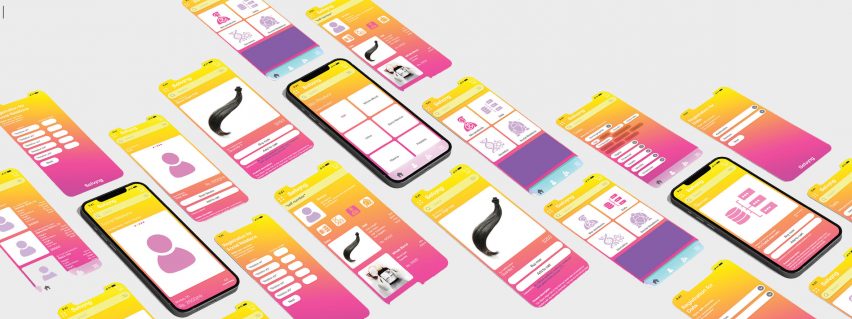
Selving: Market of selves by Pradeep Singh
"Pradeep Singh's final design project is a critical and speculative design intervention that calls for action.
"The project speculates human commoditisation as a means of income caused by the loss of jobs due to automation. Humans are thus thrust into market relations that 'empowers'them by commodifying themselves.
"The market-determined domains under which humans are commodified are data, bio-products, genetics, social relations and neural. Each develops respective critical thresholds morphing human commodities."
Student: Pradeep Singh
Course: Final Design Project
Tutor: Shemal Pandya
Email: pradeep[at]thedesignvillage.org
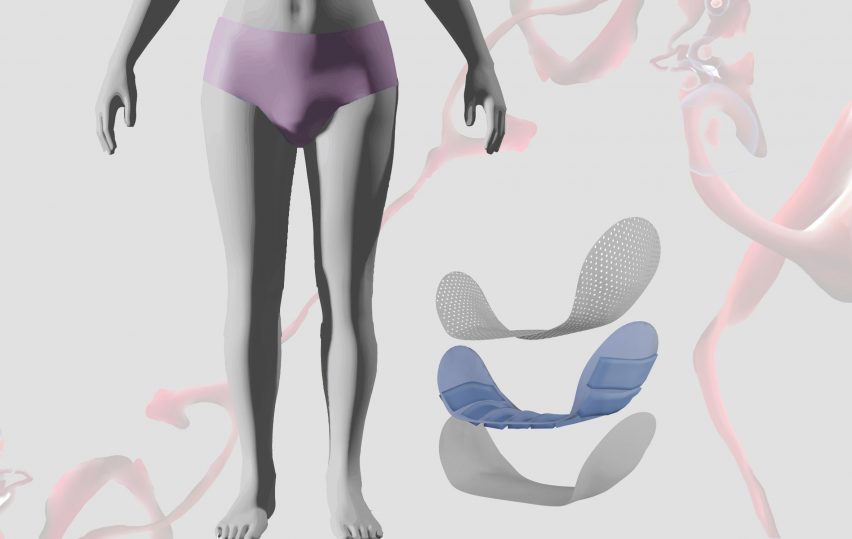
Period by Akshita Maheshwari, Kashish Jain, Muskan Jain, Riya Prajapati
"As a part of the annual biodesign studio at The Design Village, a cohort of interdisciplinary learners took forth the challenge to tackle the taboo around menstruation.
"With a specific focus on a segment of population that menstruates and the future of healthcare, they developed a product that works as a non intrusive method of extracting stem cells (menSCs) present in period blood."
Students: Akshita Maheshwari, Kashish Jain, Muskan Jain, Riya Prajapati
Course: Bio Design
Tutor: Sneha Ravishankar
Emails: akshita.maheshwari_ug20[at]thedesignvillage.org kashish.jain_ug20[at]thedesignvillage.org muskan.jain_ug20[at]thedesignvillage.org and riya.prajapati_ug20[at]thedesignvillage.org
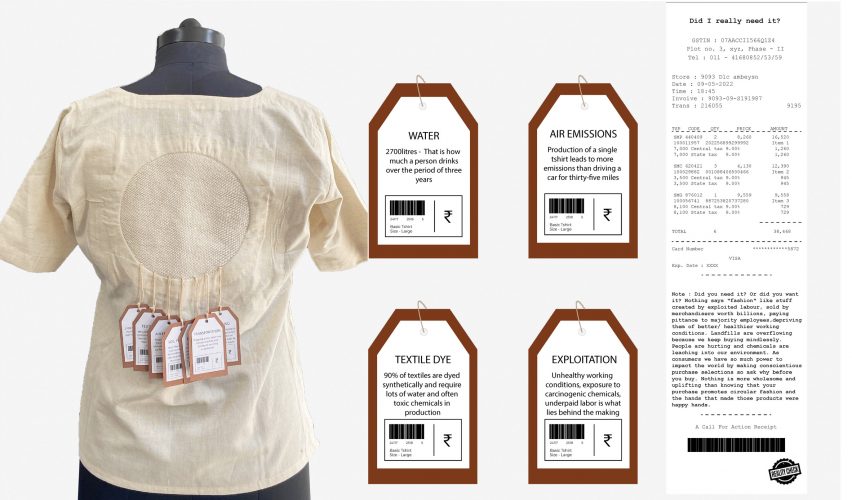
Fashion Reset by Anshika Sood
"Anshika's final design project aims to fully understand the reason why luxury fashion brands feel the need to destroy billions' worth of their own merchandise and use a design approach that would provoke conversations and make people think about the possible consequences of their choices.
"As a part of the experiment, she wove a portion of a shirt to show the zoomed-in warps and wefts of the fabric, which formed a metaphor of zooming into the production process.
"The intent was to portray how many little steps and resources go into the making of something as simple as a basic t-shirt.
"Price tags placed on the garment talk about the true cost of production instead of just its monetary value."
Student: Anishka Sood
Course: Final Design Project
Tutor: Vatsal Agrawal
Email: tdvanshika[at]thedesignvillage.org
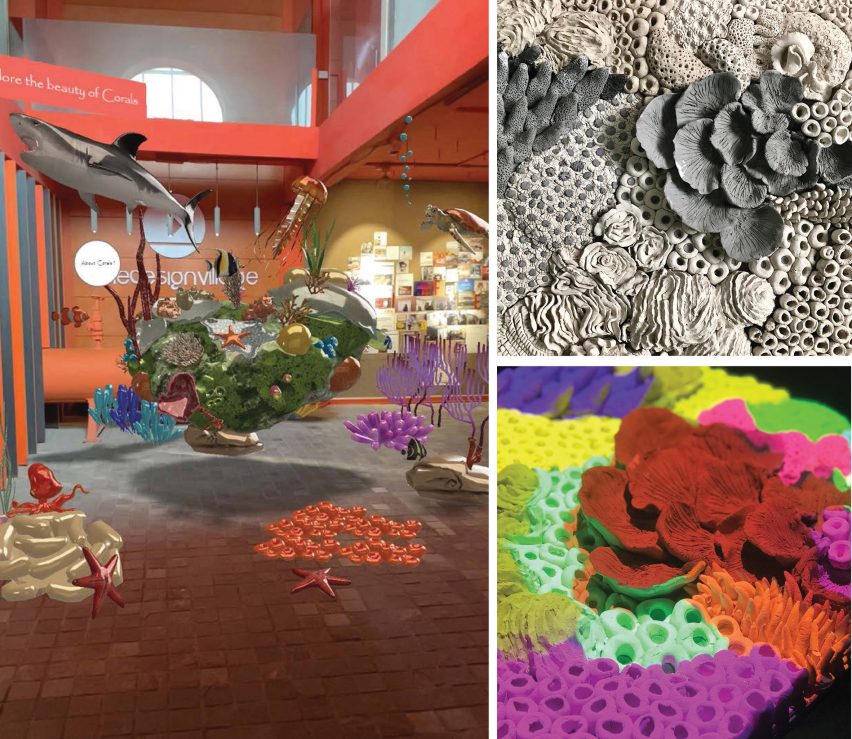
Fading Cities Of Underwater – the Depletion of Corals by Himanshu Tiwari
"Himanshu Tiwari's final design project aims to bring awareness to the urban youth about the bleaching of corals and how humans have invaded their ecosystems by becoming the cause of the phenomenon.
"This includes coral bleaching through an immersive experience integrating augmented reality, 3D projection mapping and mixed reality.
"Modalities the experience takes one through a journey that begins with a close to the life experience of corals in their unaffected form to human actions and its effects and culminates at a rather bleak but provocative image of bleached corals."
Student: Himanshu Tiwari
Course: Final Design Project
Tutor: Ananya Agrawal
Email: tdvhimanshutiwari[at]thedesignvillage.org
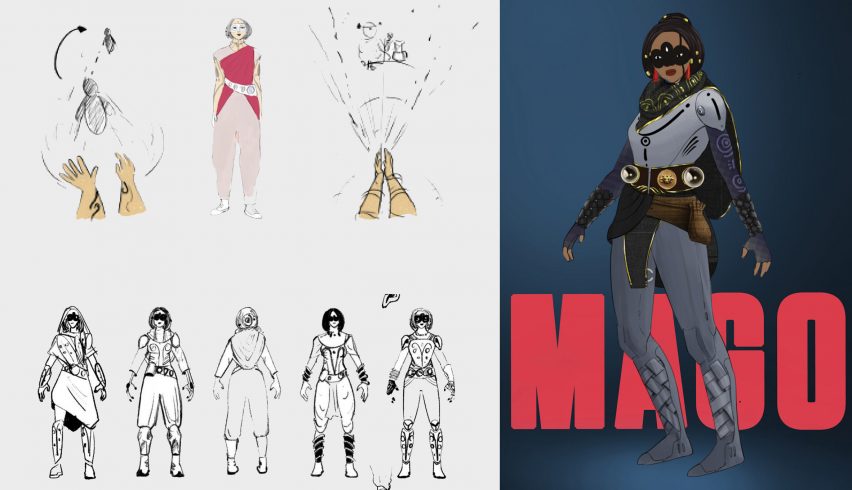
Indigenous Character Design for the Valorant Universe by Shubham Mishra
"For their final design project, Shubham Mishra designed a character for the popular game Valorant, inspired by the indigenous people in the Indian subcontinent, while aiming to increase the representation of this large population.
"The final character Mago is inspired from an 'adivasi' [tribal] community in India and their powers have been derived from the narratives and cultural nuances of the Mago community."
Student: Shubham Mishra
Course: Final Design Project
Tutor: Ritwick Nandi
Email: tdvshubhammishra[at]thedesignvillage.org

Breaking Stigmas with Stigo by Radhika Thapar
"Radhika Thapar's Stigo is a powerful tool to reclaim the self – to be able to look beyond how others view us – giving us the opportunity to be unabashedly ourselves.
"Stigo is a preventive tool that works through different communication systems. It is especially focused on men who experience male balding patterns irrespective of age. Stigo regulates the wellbeing of the office environment – through working on the roots of bad mental health, stigmatising issues and empowering individuals often falling prey to such stigma.
"Stigo aims to destigmatise work culture for people regardless of gender and promotes body positivity. The project is primarily aimed at highlighting stigma and shame associated with male pattern balding and identity formation around the same."
Student: Radhika Thapar
Course: Final Design Project
Tutor: Vatsal Agrawal
Email: radhika[at]thedesignvillage.org
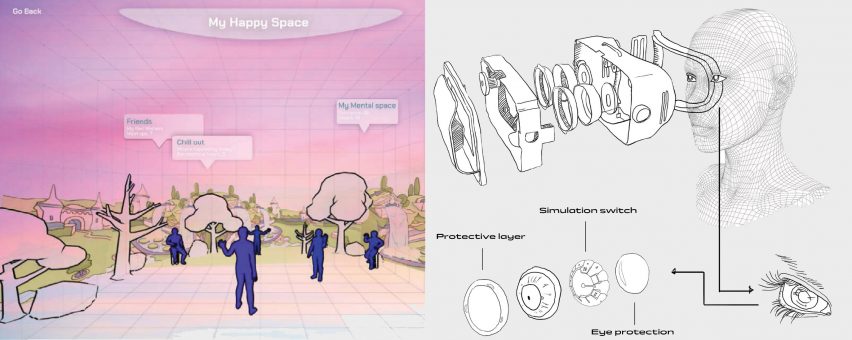
Triggers: A speculative design intervention for mental wellbeing in the metaverse by Abhik Borah
"Abhik Borah's final design project aims to bring prompts for mental health risk management intervention set in a future dystopian setting.
"It's a speculative design project that focuses mostly on how mental health can be put first in a dystopian setting where people exist moreover in their simulated world than a physical one, read metaverse.
"The project enquired if this world would be empathetic and safe in terms of mental wellbeing."
Student: Abhik Borah
Course: Final Design Project
Tutor: Nikhil Tailang
Email: tdvabhik[at]thedesignvillage.org
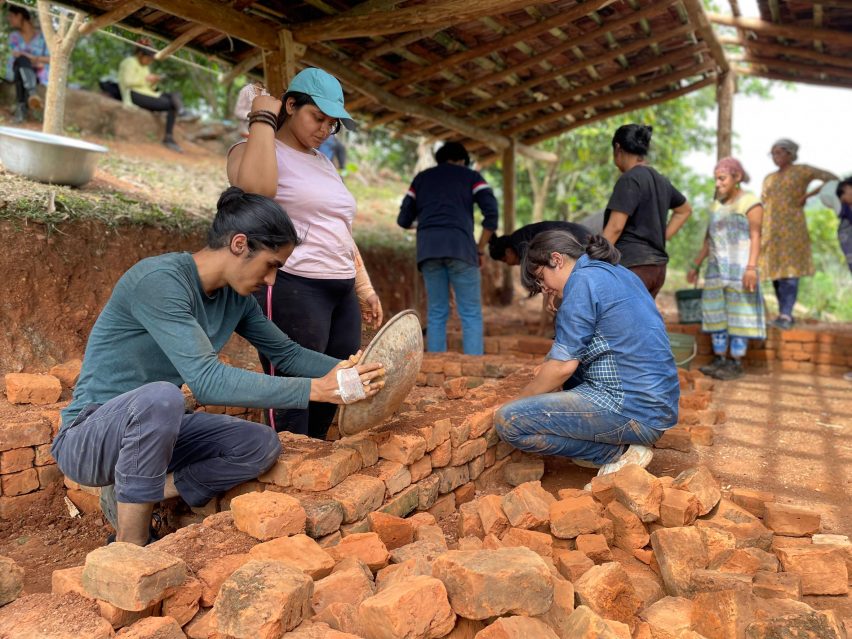
Group project: Developing biopits in the Araku tribal valley
"A team of second-year learners built and developed an exemplary functional biopit model with locals from the indigenous community in the Araku Valley.
"This module is one across a series of participatory design development activities under the 'villaging' component of the curriculum intended to instil rigour of ground realities of audiences across a complex and diverse population.
"Villaging is a unique component of our pedagogical model and allows us to ground ourselves and develop the much-needed soft skills in a designer of tomorrow."
Students: Abhik Borah by Aastha Mehdiratta, Akshay Garnara, Akshita Maheshwari, Agamdeep Kumar Jain, Aritra Maitra, Devpriya, Digvijay Shukla, Harshit Gupta, Hritika Saroha, Jugaadh Singh Lamba, Kashish Jain, Kavya Bhadwal, Kamakshi Sharma, Lewna Deb, Parnika Malik, Sumit Gautam, Shubhiksh G and Tanvi Vasdev
Course: Villaging
Tutors: Akanksha Chhajer, P. Dharun Rao and Pritesh J. Maru Guided, facilitated by the Naandi foundation
Partnership content
This school show is a partnership between Dezeen and The Design Village. Find out more about Dezeen partnership content here.